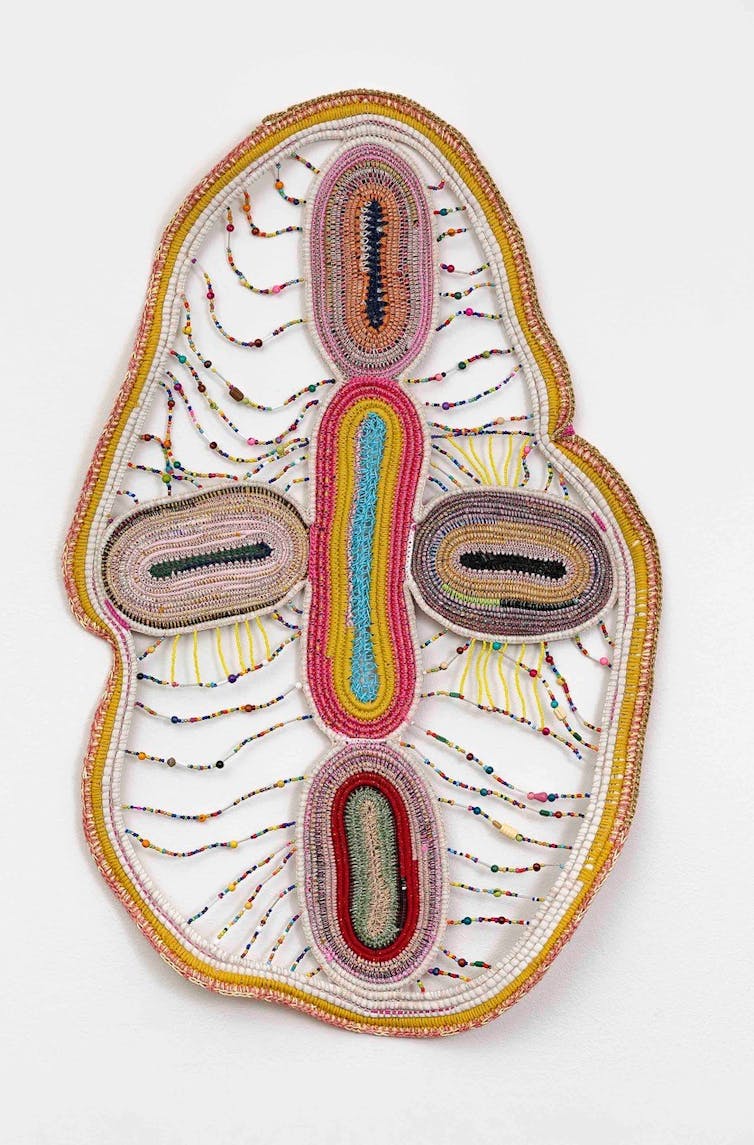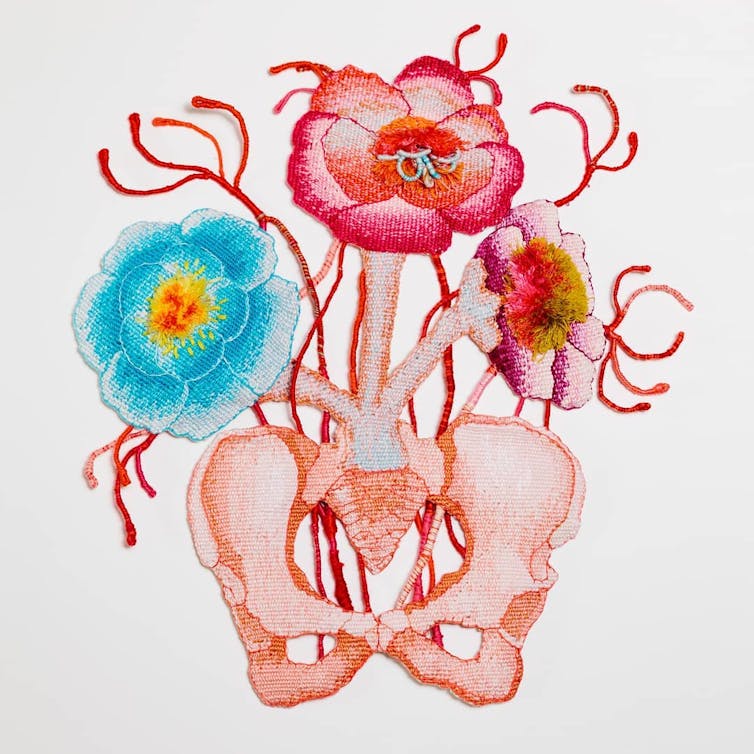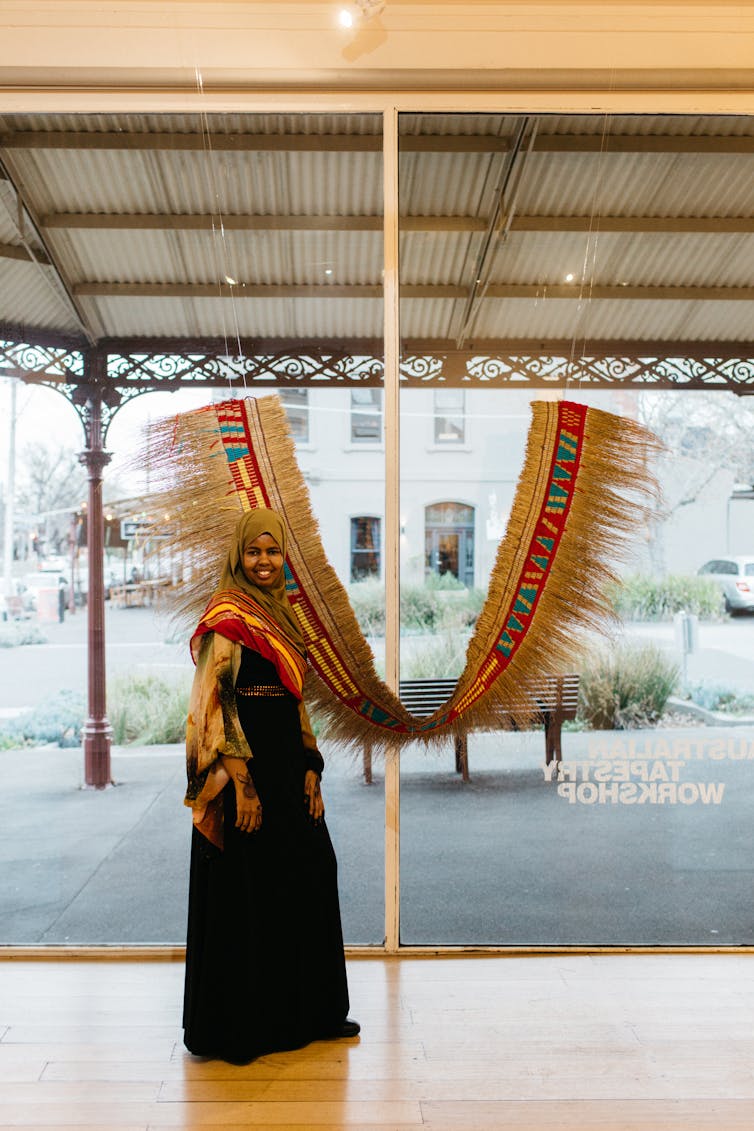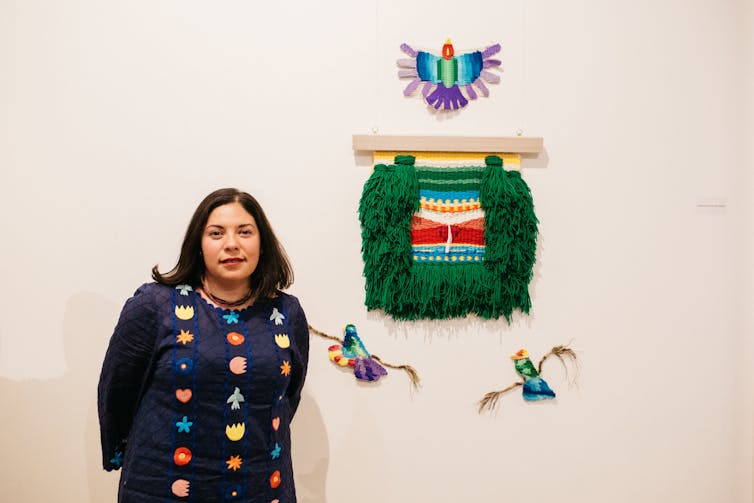tapestries interweave traditions with a new sense of place
- Written by Sue Green, Deputy Co-ordinator, Journalism Program, Swinburne University of Technology
The spare, white-walled Australian Tapestry Workshop gallery is very much of its place, a wall of windows fronting the South Melbourne street. Cars, trams and shoppers are just metres away, the occasional pedestrian observing the observer. It’s a stark space ill-suited to introspection, but perhaps apposite given that the eight artists showing here are examining their own place and the intersection of their heritage with life in present-day Australia.
Five are migrant women drawing on textile traditions in exploration of their identity in a contemporary Australian context, although little information is provided to illuminate those traditions. Two or three paragraphs in the free program’s four pages of notes are devoted to each artist and, for all except two, this information is duplicated on a wall plaque. More about the artists, their works and the techniques used might have enabled a more nuanced appreciation.
 Paula do Prado, El Grito, 2018, cotton, wool, hemp, linen, raffia, Bobbiny cotton rope, twine, paper covered wire, wire, glass seed beads, wooden beads, açai seed beads. 110 x 60 x 5cm.
Photo: Document Photography
Paula do Prado, El Grito, 2018, cotton, wool, hemp, linen, raffia, Bobbiny cotton rope, twine, paper covered wire, wire, glass seed beads, wooden beads, açai seed beads. 110 x 60 x 5cm.
Photo: Document Photography
The woven tapestry style associated with the Australian Tapestry Workshop features in some work. Karen migrant Mu Naw Poe learned weaving from her mother and continued it in a refugee camp for 20 years. Once in Australia she undertook an Australian Tapestry Workshop program. Her Night Sky 2018 and Global Warming 2014 are bold, multicoloured geometrics; Faces 2016 is more abstract. The three woven strips of Here We Are Sisters 2018 by noted textile artist Kay Lawrence record the names of participants in a Women’s Wealth Project in traditional European storytelling style.
For Ema Shin, of Japanese and Korean descent, such techniques are the starting point for two densely woven, three-dimensional works, Soft Alchemy (My Pelvic Bone) 2018 and Soft Alchemy (Fertile Heart) 2019. Referencing her pregnancy and including tufted Korean floral symbols of fertility, she adds padding and wrapped wire to produce an alarming profusion of veins.
 Ema Shin’s Soft Alchemy (My Pelvic Bone), 2018, cotton, wool, wire woven tapestry.
Photo: Oleksandr Pogorilyi
Ema Shin’s Soft Alchemy (My Pelvic Bone), 2018, cotton, wool, wire woven tapestry.
Photo: Oleksandr Pogorilyi
Lisa Waup’s works also have a 3D quality. A Gunditjmara and Torres Strait woman, her small, woven vessels combine thread, feathers, found objects, even false hair. Her three-part 2019 series It’s in my DNA symbolises passing her DNA to her children, while the other, Past, Present, Future 2019 references living family and ancestors.
Indigenous Australian Bronwyn Razem (Gunditjmara/Kirrae Whurrong), a Master Weaver, is keeping alive weaving skills used to create a traditional eel trap and the weaving’s cultural importance. Eel Trap 2018, is precisely that – a metre-long raffia trap, as used by her people in Victoria’s Western District. The program notes she has played a vital role in this trap’s revival but this information is tantalisingly brief.
Somali weaver Muhubo Suleiman’s Raar 2018 hangs in the window with no identifier, the program revealing who made it and her use of traditional Somalian finger weaving, once essential in nomadic communities, now evoking home in her new country.
 Muhubo Suleiman with Raar (2018)
Photo: Marie-Luise Skibbe
Muhubo Suleiman with Raar (2018)
Photo: Marie-Luise Skibbe
Three striking beaded works by Uruguayan migrant Paula Do Prado, one of which, El Grito 2018, is on the program cover, are described as using traditional and non-traditional craft techniques and materials. Open shapes are made from beaded wire and blanket-stitched rope. The work is described as “highly personal and autobiographical”, but just how so remains elusive. So, too, Yunuen Perez’s weaving, which draws on Mexican Indigenous stories and traditional textile techniques.
 Artist Yunuen Pérez with Ketzal (2016) and Colibries (Hummingbirds) (2019).
Photo: Marie-Luise Skibbe.
Photo: Marie-Luise Skibbe
Artist Yunuen Pérez with Ketzal (2016) and Colibries (Hummingbirds) (2019).
Photo: Marie-Luise Skibbe.
Photo: Marie-Luise Skibbe
This is a small but important exhibition, showcasing textile work by women of extraordinary patience, dexterity and expertise. Traditional techniques are given new life, record reflections, keep history alive and salve divided loyalties by weaving links between home and home. Rich histories, personal and cultural, are embedded in these works but the audience is denied access to these histories given the paucity of information available about them.
Place Makers can be viewed at the Australian Tapestry Workshop until December 6. A community workshop will be held on Saturday 16 November
Authors: Sue Green, Deputy Co-ordinator, Journalism Program, Swinburne University of Technology



